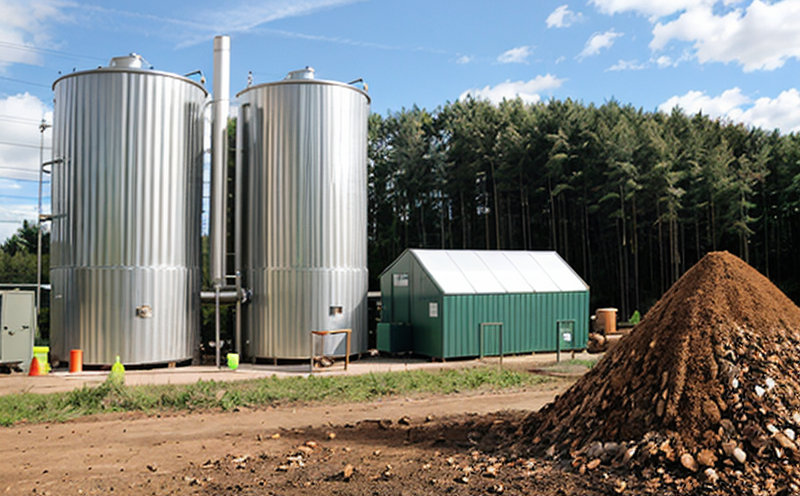ASTM D4239 Sulfur Content in Biomass and Waste Fuels
The ASTM D4239 standard is widely recognized as a crucial method for determining the sulfur content in biomass and waste fuels. This test plays an essential role in ensuring compliance with environmental regulations, improving fuel quality, and enhancing overall energy efficiency during waste-to-energy conversion processes.
Sulfur content measurement is critical because high levels of sulfur can lead to increased emissions of sulfur dioxide (SO₂), which contributes significantly to air pollution. By accurately measuring the sulfur content using ASTM D4239, industries can optimize fuel quality, reduce emissions, and ensure that their products meet stringent environmental standards.
The test involves several key steps: sample preparation, digestion, absorption, titration, and calculation of results. Samples are typically prepared by drying and grinding biomass or waste fuels to a consistent particle size. Digestion is performed using a strong acid solution in an oven at elevated temperatures. The sulfur content is then absorbed into a suitable absorbent material before being titrated with a standard solution.
Accurate measurement of sulfur content is vital for several reasons:
- To ensure compliance with environmental regulations such as ISO 15218-1 and EN 14962.
- To optimize fuel quality, which directly impacts combustion efficiency and emissions.
- To enhance the performance of waste-to-energy conversion processes by ensuring consistent feedstock quality.
Understanding the sulfur content in biomass and waste fuels is essential for various stakeholders:
- Quality Managers: Sulfur content data helps them monitor fuel quality and ensure consistency across batches.
- Compliance Officers: It enables them to verify that their products meet regulatory requirements, thus reducing the risk of legal penalties.
- R&D Engineers: Accurate sulfur content measurements provide valuable insights into improving fuel formulations and optimizing conversion processes.
- Procurement Professionals: They can use this information to source high-quality feedstocks that meet specific performance criteria.
The ASTM D4239 method is robust, reliable, and widely accepted. It ensures consistent results across different laboratories, making it a cornerstone of quality assurance in the waste management sector. This standard supports industries ranging from renewable energy to environmental services by providing a standardized approach to sulfur content measurement.
Quality and Reliability Assurance
The ASTM D4239 method is renowned for its high degree of reliability and reproducibility. The following are key aspects that contribute to the quality and reliability:
- Standardized Procedure: The ASTM D4239 standard provides a detailed, step-by-step procedure that ensures consistent results across different laboratories.
- Digestion Efficiency: Proper digestion is critical for accurate sulfur content determination. The method specifies the use of strong acids and high temperatures to ensure complete breakdown of organic matter.
- Absorption and Titration Accuracy: Precise absorption and titration steps are essential for achieving reliable results. These steps require careful handling and precise instrumentation.
- Calibration: Regular calibration of instruments ensures that measurements remain accurate over time.
The ASTM D4239 method is validated by numerous international standards, including ISO 15218-1 and EN 14962. These standards provide additional layers of assurance for the reliability and accuracy of the test results. Laboratories that adhere to these standards are able to produce consistent and accurate measurements, which is crucial for maintaining compliance with environmental regulations.
For industries reliant on waste-to-energy conversion processes, accurate sulfur content measurement is not just a technical requirement but also a strategic advantage. By ensuring high-quality fuel inputs, companies can optimize their operations, reduce emissions, and enhance the overall efficiency of their processes.
International Acceptance and Recognition
The ASTM D4239 method is widely accepted and recognized globally. Its broad acceptance is due to its robustness and reliability in providing accurate sulfur content measurements. Many countries have adopted this standard as a reference for their own regulatory frameworks, ensuring consistency across international borders.
Several key regions and organizations recognize the ASTM D4239 method:
- European Union (EU): The EU has incorporated ASTM D4239 into its environmental regulations to ensure consistent sulfur content measurement across member states.
- American Society for Testing and Materials (ASTM): As the standard was developed by ASTM, it is widely accepted in North America and internationally.
- International Organization for Standardization (ISO): ISO standards often align with ASTM D4239, further enhancing its global recognition.
The widespread adoption of ASTM D4239 ensures that laboratories using this method can produce results that are universally accepted. This is particularly important in industries where cross-border operations or international partnerships are common. By adhering to a globally recognized standard, companies can ensure that their measurements are comparable and consistent with industry best practices.
Recognition of ASTM D4239 extends beyond regulatory compliance into the realm of quality assurance. Laboratories that use this method can demonstrate their commitment to providing accurate and reliable data, which is essential for maintaining trust and credibility in the waste management sector.
Competitive Advantage and Market Impact
Accurate sulfur content measurement using ASTM D4239 provides significant competitive advantages and market impacts:
- Improved Fuel Quality: By ensuring high-quality fuel inputs, companies can reduce emissions and improve the overall efficiency of their waste-to-energy conversion processes.
- Enhanced Compliance: Adherence to ASTM D4239 ensures that companies meet regulatory requirements, reducing the risk of legal penalties and fines.
- Informed Decision-Making: Accurate sulfur content data allows for informed decision-making in procurement and R&D. This leads to more efficient processes and better product quality.
- Better Reputation: Demonstrating compliance with globally recognized standards can enhance a company's reputation, making it more attractive to partners and clients.
The market impact of accurate sulfur content measurement is profound. It not only ensures regulatory compliance but also drives innovation in waste management and energy conversion technologies. Companies that prioritize ASTM D4239 are better positioned to meet the growing demand for sustainable and efficient energy solutions.
In conclusion, the use of ASTM D4239 provides a robust framework for accurate sulfur content measurement, which is essential for maintaining compliance with environmental regulations, optimizing fuel quality, and enhancing overall efficiency in waste-to-energy conversion processes. By adhering to this standard, companies can gain significant competitive advantages and contribute positively to market trends.





